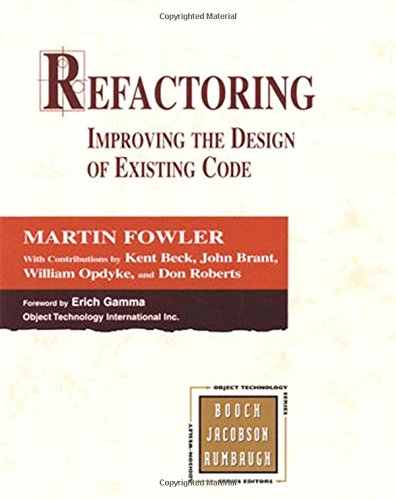Refactoring: Improving the Design of Existing Code book
Par otis darlene le lundi, mars 20 2017, 09:00 - Lien permanent
Refactoring: Improving the Design of Existing Code. Don Roberts, John Brant, Kent Beck, Martin Fowler, William Opdyke

Refactoring.Improving.the.Design.of.Existing.Code.pdf
ISBN: 0201485672,9780201485677 | 468 pages | 12 Mb

Refactoring: Improving the Design of Existing Code Don Roberts, John Brant, Kent Beck, Martin Fowler, William Opdyke
Publisher: Addison-Wesley Professional
Refactoring: Improving the Design of Existing Code. I think people see refactoring as a difficult process. After picking it up a few months ago, it took me a while to finish reading it. Software developers are professionals. Refactoring: Improving the Design of Existing Code By Martin Fowler is another timeless classic suggested by @Pratap, This book is also in my wish list and next in my reading queue. Move the field to the superclass.(2)Pull Up MethodYou have methodswith identical results on subcl. The term “code smell” is attributed to Kent Beck in Martin Fowler's book Refactoring, Improving the Design of Existing Code (Addison-Wesley, 1999, ISBN 0-201-48567-2). Free download eBook:Refactoring: Improving the Design of Existing Code.PDF,epub,mobi,kindle,txt Books 4shared,mediafire ,torrent download. My experience is that refactoring is a big ait to building software quickly. Usage of the term increased after it was featured in Refactoring: Improving the Design of Existing Code.[1] Code smell is also a term used by agile programmers.[2]. Design is hard; so improving design of existing code must be hard, as well, right? Http://www.storytellersoftware.com Mark Mahoney. Beck, “Refactoring: improving the design of existing code”, Addison Wesley Longman, 1999, pp.238 – 240. I've long been told that this book is one of the must-reads for developers. Chapter 11 Dealing with Generalization(1)Pull Up FieldTwo subclasseshave the same field. [3, 4] In his book on refactoring . Refactoring is defined as a disciplined technique for restructuring an existing body of code, altering its internal structure without changing its external behavior. Martin Fowler / Kent Beck / John Brant / William Opdyke / Don Roberts; Publisher: Addison Wesley. For instance, RTL refactoring can be used to abstract and understand a design [6], prepare a design for other purposes such as validation or elastization [2], optimize a design for specific tools such as synthesis or to simply improve the design of existing code [3]. Our job is to build effective software as rapidly as we can.